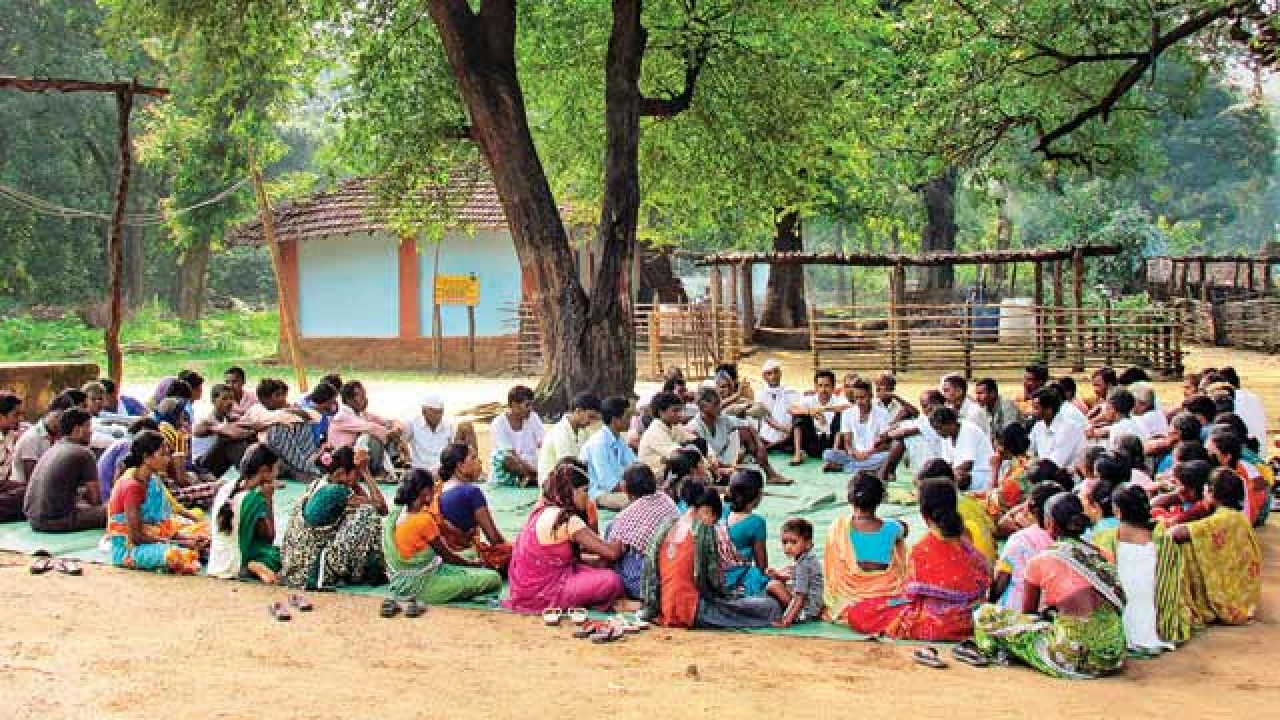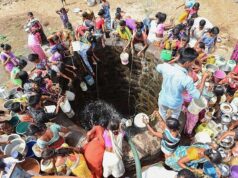On 2 October 2021, hundreds of Adivasi forest-dwellers marched against the coal mining project in Hasdeo Arand, Chhattisgarh. Their call to action? Revoking clearance to the Parsa Open Cast mine. This project, although worth more than Rs 1960 crore, would affect the livelihoods of 995 families and inflict major losses on one of India’s biggest biodiversity reserves. Such a tussle between indigenous livelihoods, resource extraction, and conservation is not new for 275 million forest-reliant people in India. The deer caught in the headlights is the authority responsible for granting the clearance – the Gram Sabha. This article proposes that despite the existing framework of rights, Gram Sabha needs power in both letter and spirit to be an effective institution representing forest dwellers.
Gram Sabha represents the Gandhian ideal of self-sufficient village republics and decentralisation of power to the local level. Laws pertaining to forest rights in India, such as the Forest Rights Act (FRA), 2006 and the Panchayats (Extension to Scheduled Areas) Act, PESA, 1996 have attempted to make the Gram Sabha the nucleus of decision making in rural areas. These laws, though well-intentioned, have not been implemented to their full extent.
Three main flaws ail the proper functioning of the Gram Sabha: State forest departments hold a monopoly over minor forest produce despite the FRA granting ownership rights to the Gram Sabha. The Gram Sabha is further rendered ineffective due to its improper constitution. It is also not representative of local interests. In practice, multiple villages, instead of a single village, are pooled under one Gram Sabha. Further, the Gram Sabha has inadequate decision-making power and is unable to process claims for individual and community forest rights.
The Gram Sabha as per the Forest Rights Act, 2006 is meant to
(a) initiate the process of determining the nature and extent of forest rights, receive and hear the
claims relating thereto;
….(c) pass a resolution on claims on forest rights after giving reasonable opportunity to interested persons and authorities concerned and forward the same to the Sub-Divisional Level Committee” (Section 4.1).
In addition, the Panchayats (Extension to Scheduled Areas) Act, PESA, 1996 mandates consultation with Gram Sabha before any land acquisition, with Section 4(f) outlining the following:
“Every Panchayat at the village level shall be required to obtain from the Gram Sabha a certification of utilisation of funds by that Panchayat for the plans, programmes and projects.”
But in many instances, the state forest department has been issuing the notices for such acquisition. In Hasdeo, the Hasdeo Aranya Bachao Sangharsh Samiti filed FIRs alleging that the meeting approvals and clearance documents have been forged and were not consented to by the respective Gram Sabha (Menon, 2021). Inserted to prevent the alienation of lands for mineral exploitation, the lack of stringent implementation of these laws has put the ecological and economic interests of the local communities at risk.
In 2015, the Gauhati High Court reiterated the pivotal role of the Gram Sabha in Kabin Ronghang and Others v. Union of India and Others. The Court adjudicated that the Gram Sabha is only the appropriate authority to initiate the process for determining the nature and extent of individual and community forest rights. In reality, the Gram Sabha is unable to fulfill this function due to its improper constitution. The Forest Rights Act mandates the institutionalisation of Gram Sabha at the level of an individual village, implying the presence of one Gram Sabha per village (Baginski and Sarin, 2010.)
However, in most states, Gram Sabhas are recognised at the Gram Panchayat level which consists of many villages. For instance, in West Bengal, due to a large number of small villages, ‘Gram Sansads’ have emerged in place of Gram Sabhas. The average number of villages per Gram Sansad is 11.7, contrary to the one village-one Gram Sabha vision. Convening a single Gram Sabha for multiple revenue villages is a serious challenge for the villagers involved as it involves converging thousands of people from across many separate settlements (Baginski, Sarin, 2010). This practice might be undertaken to meet the necessary quorum for meetings. The quorum for Gram Sabha meetings is the presence of 50% of all villagers. In addition, women must constitute 1/3rd of all attendees (JFM Handbook, Ministry of Environment, Forests and Climate Change). This informal practice makes meetings inaccessible for peripheral regions and as a result, local concerns are not well represented (Madhya Pradesh Committee Report, 2010).
Another issue pertains to the nature of power sharing between the Gram Sabha and its associated bodies. The Forest Rights Committee (FRC) is the constituent body of the Gram Sabha. It submits the received claims to the Sub-Divisional and District Level Committees. The Forest Rights Act requires that both the SDLC and DLC should have six members—three government officials from the tehsil and block level and three people’s representatives elected by the Gram Sabha.
Although the seats are distributed equally between the government officials and people’s representatives in the DLC and SDLC, government officials are granted the position of chair in both Committees, giving them the final decision-making power. Since the Act does not specify the weightage that governmental and non-governmental members of the Committees will hold, this results in a de facto authority of the Forest Department. Vertical decentralization needs to be accompanied by a process of horizontal decentralization which increases the number of decision makers, enhancing guidance and accountability at all levels (Ranis, 2019). In many instances, this has resulted in large scale rejection of claims for individual and community forest rights filed under FRA. States like Gujarat, Jharkhand and Tamil Nadu had processed (accepted or rejected) less than 40% of the claims received. Besides, the percentage of rejection was high in Karnataka (89%) and Chattisgarh (55%). A major issue in most states was the wrongful rejection of these claims. While most did not specify the reason for rejection, others cited the absence of GPS measurements, both of which are invalid reasons under FRA (Madhya Pradesh Committee Report, 2010).
UNDP Global Multidimensional Poverty Index 2021 points out that five out of six poor people are from lower tribes or castes in India. The Scheduled Tribes (STs), occupying a dominant place in the Hasdeo Arand demographic, are the poorest in the nation, comprising 65 million of the 129 million people living in abject poverty. The Hasdeo Arand demonstration is a strong clarion call to invest efforts in making Gram Sabha the fulcrum of deliberative and participatory democracy by protecting the livelihood of tribals and forest-dwellers. On-ground issues in the implementation of these forest laws have made the Gram Sabha an inadequate guarantor of forest rights. Although the Gram Sabha has been pitted as a panacea to a dominant bureaucracy, its functioning has been impaired due to inadequate power transfers. It is important to enhance the operational and coercive capacity of Gram Sabhas for it to enable better economic growth and rural development. By ensuring its constitution at each individual village level, monitoring its rate of processing claims and enforcing regular meetings, the Gram Sabha can go beyond being a rubber stamp.
Read more: Keeping up with Technological Advancements
Post Disclaimer
The opinions expressed in this essay are those of the authors. They do not purport to reflect the opinions or views of CCS.






